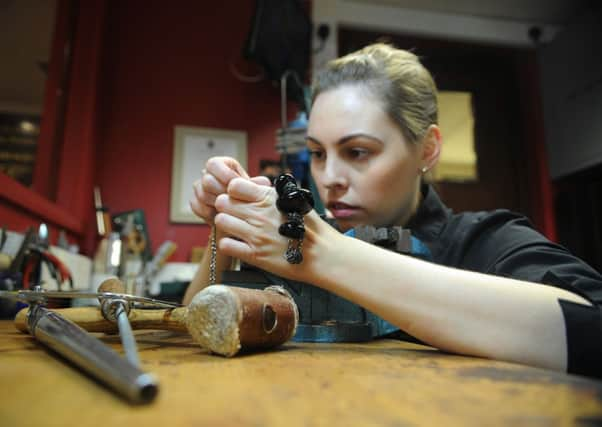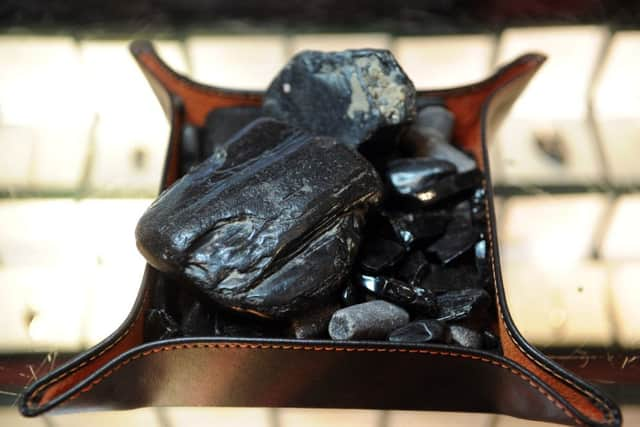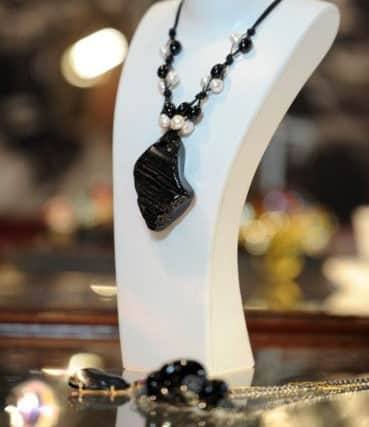Hidden gem: Jet gets set to take off


When the sun shines on the East Coast and temperatures rise for any significant period of time, in a small corner of Whitby, Rebecca Tucker can sometimes be found quietly praying for a violent storm or at the very least a significant downpour.
While the town tends to be busy all year round with tourists, the summer holidays remain its peak season and with many visitors wanting to take away a piece of Whitby jet jewellery as a memento, stocks of the black stuff invariably run low.
Advertisement
Hide AdAdvertisement
Hide Ad“A hundred years ago there was a whole industry built up around mining jet. However, it was made illegal in the late 19th century, partly because it was incredibly dangerous, but also to prevent further coastal erosion and since then we’ve had to rely on natural deposits,” says Rebecca, the in-house jeweller at WH Hammond – The Original Whitby Jet Shop.


“We have a group of about 10 beachcombers who go out searching for jet and you tend to find more after bad weather has disturbed the rocks on the cliffsides around here. During the summer when I’m at my workbench looking at an empty box where the jet should be, they’ll often get a call from me asking if they might like to have a walk along the beach. These days, finding large deposits is quite rare, so when we do get them we tend to keep them for a special commission.”
Formed from fossilised monkey puzzle trees, jet, along with Derbyshire Blue John, is the only precious stone native to the British Isles. Found along a small stretch of the coast in an area which has just a 10-mile radius, while stocks aren’t exactly running out, demand is likely to intensify as WH Hammond attempts to capitalise on what it calls the Downton Abbey effect by taking the stone and its heritage to the American market. The company has recently secured its first major US deal with a firm in Knoxville and has just completed the first order for 3,000 pieces.
“You do find it in countries like China, Siberia and America, but the finest quality jet comes from here,” says Rebecca, who trained in jewellery design at Birmingham City University before joining the company five years ago. “It’s basically posh coal and in Yorkshire, pretty much everyone has heard of Whitby jet. However, outside of the county it’s still largely unknown. It’s provenance and the fact that it can only be found here is what makes it special, but there is a real opportunity for us to take jet to somewhere like America where there is a big appetite for anything related to British heritage.
Advertisement
Hide AdAdvertisement
Hide Ad“The deal with Knoxville began following a talk I did at an event organised by the Gem Association. As a result of that we were invited out to America and they not only loved the product, but they loved the story behind it.”


While British customers tend to favour more delicate designs, perhaps predictably the Americans prefer their jet to make more of a bold statement, favouring styles reminiscent of the Victorian jewellery when the industry was in its heyday.
“Given its colour, it’s perhaps not surprising that it was used for mourning jewellery and was worn by Queen Victoria following the death of Prince Albert,” says Rebecca, who as well as now being an expert on design has also spent the last five years researching the stone’s history with the hope of opening a small museum within the shop. “However, what people don’t realise is that it really didn’t take much for the Victorians to go into mourning. It could even be triggered by the death of a pet, so sales of jet did pretty well.”
In the shop, nestled just below the 99 steps leading up to the abbey, there are a couple of cases dedicated to those original designs. Some of the antique pieces are for sale, but only at the right price and with fashion having moved on they are mainly there as exhibition pieces.
Advertisement
Hide AdAdvertisement
Hide Ad“There is a lady in Leeds whose mother had an amazing collection of jet. When she died she wanted it to go on public display and originally offered it to the museum at Pannett Park which already has a small collection of jet. They told her that because space was limited the collection would probably end up in store. It seemed such a shame that no one would get to see it, so in the end it came to us.”
Part of the beauty of jet is that despite its dense, heavy appearance it’s actually incredibly light, so even the large pieces are very wearable. The company’s signature piece is a heart shaped necklace, but the town’s links with the Goth community has brought in a very different customer, one wanting large jet crosses and spider shaped rings.
While the more intricate pieces can take days to complete, Rebecca can now turn out a simple ring in just over an hour.
“I had no experience in stone cutting, but I spent six months training at the company’s headquarters in Derbyshire and then moved to Whitby. The shop hadn’t had its own workshop for years, but there is something really nice about buying a piece of jewellery and knowing where and how it was made.
Advertisement
Hide AdAdvertisement
Hide Ad“The thing about jet is that until you start working with it you can never quite tell how good a piece it is. You might take off the top layer and find there is a flaw running right through it, but it is a very forgiving stone to work with.”
Rebecca is based in a workshop at the back of the shop and it takes her just a few minutes to shape a small piece of jet on a grinding wheel so it fits perfectly into a ring casing. Each piece is hand crafted and while computers are now used in the design process much of the equipment is the same as it was 150 years ago when the shop was first opened by James Storr.
Another designer is currently being trained in Derbyshire and when she arrives, Rebecca hopes to have more time to promote the brand’s heritage.
“Look at these, aren’t they incredible?” she says, grabbing a couple of ornate-looking photograph albums. They’ve been wrapped in Clingfilm to prevent dust degraded the images, many of which date back to jet’s heyday. While archaeologists have found jet jewellery dating back to the Bronze Age and it was known to have been popular in Roman times, it wasn’t until the middle of the 19th century that it helped to transform the economy of Whitby.
Advertisement
Hide AdAdvertisement
Hide AdThe first workshop opened in 1808 and by 1851, when examples were shown at the Great Exhibition, it already had an international customer base and was particularly popular among the French royal family.
“In the 1870s there were 1,700 people employed in the industry and 200 workshops making and selling jewellery,” says Rebecca, who grew up in Holmfirth. “It wasn’t without its dangers. Those who mined the stuff were lowered down the cliffside on ropes and the dust which is produced when you work the stone is highly combustible. Given that many of the workshops were lit with kerosene lamps it is probably not surprising that many burnt down, but many thought the risks were worth the rewards.
“Whitby, which also had a thriving fishing industry, boasted full employment and it was a very affluent place to be. However, within a decade the decline in sales had begun and the bottom fell out of the industry incredibly quickly. But it happens, sustaining any trend which was as popular as jet is hard.”
When jet fell out of fashion, many of those who owned items simply threw them away. The revival in fortunes is relatively recent, but those involved in industry hope this time the business will prove more sustainable.
Advertisement
Hide AdAdvertisement
Hide Ad“The whole industry was forgotten; it was just wiped away,” says Rebecca. “However, Whitby is one of those places where successive generations of families tend to stay, so recently when we’ve been looking back into the archives we have managed to trace the descendants of some of those early craftsmen. We are really keen to build up a detailed picture of how jet changed this town forever.”
And if they do manage to stoke an American love affair for jet, soon it may be no longer Yorkshire’s hidden gem.